Table of Contents
Introduction
Read time: 7 minutes
Color theory is an essential aspect of floral design that can significantly impact the visual appeal and emotional response to an arrangement. By understanding and applying the principles of color theory, florists can create stunning, harmonious designs that resonate with their clients. This guide explores actionable techniques for incorporating color theory into floral design, offering practical insights for florists to enhance their craft!
Understanding Color Theory
Color theory involves the study of how colors interact, their relationships, and the effects they produce. The primary components include the color wheel, color harmony, and the psychological impact of colors.
The Color Wheel
The color wheel is a circular diagram of colors arranged by their chromatic relationship. It includes primary, secondary, and tertiary colors:
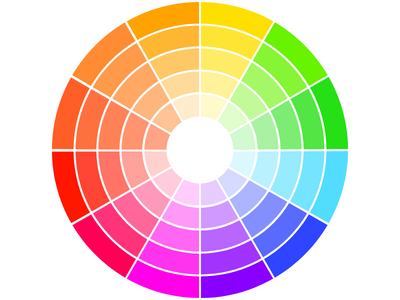
- Primary Colors: Red, blue, and yellow.
- Secondary Colors: Green, orange, and purple, created by mixing primary colors.
- Tertiary Colors: Six colors formed by mixing primary and secondary colors.
Techniques Using Color Theory
Monochromatic Schemes
Single Hue Variations
- Create arrangements using various shades, tints, and tones of a single color.
- For example, a monochromatic red bouquet can include deep burgundy, classic red, and pale pink.
Benefits
- Provides a cohesive and elegant look.
- Easy to execute and versatile for different occasions.
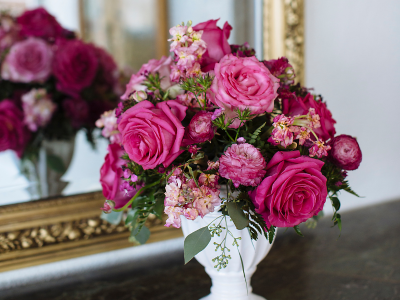
Analogous Schemes
Adjacent Colors
- Combine three colors that sit next to each other on the color wheel.
- For example, an arrangement with red, red-orange, and orange flowers.
Benefits
- Creates a harmonious and serene effect.
- Ideal for creating natural and visually pleasing designs.
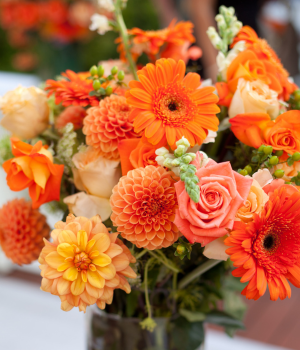
Complementary Schemes
Opposite Colors
- Use two colors that are directly opposite each other on the color wheel.
- For example, pairing red and green or blue and orange.
Benefits
- Produces a vibrant and high-contrast look.
- Excellent for making certain flowers stand out in the arrangement.
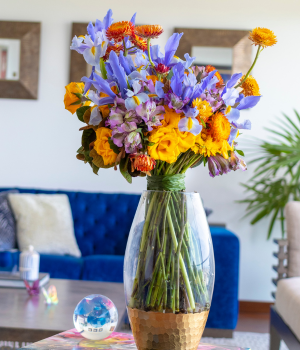
Harmony and Balance
Achieving color harmony involves creating a balanced and aesthetically pleasing composition.
Triadic Schemes
Triad Colors
- Select three colors that are evenly spaced around the color wheel.
- For example, using tones of purple/magenta, orange and green.
Benefits
- Offers a balanced yet dynamic look.
- Suitable for festive and celebratory arrangements.

Split-Complementary Schemes
Near-Complement Colors
- Choose one base color and the two colors adjacent to its complementary color.
- For example, using green, muted pink-red, and pink-purple.
Benefits:
- Provides strong visual contrast without the tension of a direct complementary scheme.
- Versatile for various design themes.
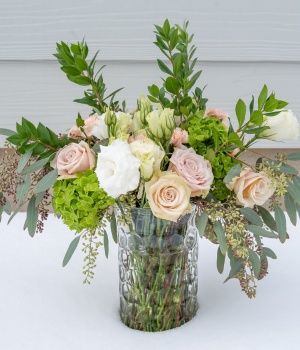
Psychological Impact of Colors
Colors evoke different emotions and associations. Understanding this can help florists create arrangements that convey the desired message or mood.
Examples Using Color Theory
Wedding Bouquets
A bride wants a romantic and elegant bouquet for her wedding.
Approach
- Use a monochromatic scheme with various shades of pink.
- Incorporate different textures and flower types to add depth and interest.
- Offer options with subtle color variations to match the wedding theme and the bride’s preferences.
Corporate Events
A company needs floral arrangements for a corporate event.
Approach
- Use a blue and white color scheme to evoke professionalism and trust.
- Add green accents to symbolize growth and harmony.
- Create arrangements that reflect the company’s brand colors and values.
Seasonal Displays
A florist wants to create a display for a springtime window.
Approach
- Use an analogous color scheme with yellow, yellow-green, and green.
- Incorporate seasonal flowers like daffodils, tulips, and greenery.
- Rotate displays seasonally to keep the shop fresh and inviting.
Pro Tips
Regularly create test arrangements using different color schemes and document the results to understand what works best in various contexts!
Use online color palette generators and apps to explore new combinations and keep a portfolio of successful color palettes for future reference!
Participate in floral design workshops and courses focused on color theory and stay updated on industry trends and techniques!
Conclusion
Color theory is a powerful tool that can transform floral designs from ordinary to extraordinary. By understanding and applying the principles of the color wheel, color harmony, and the psychological impact of colors, florists can create arrangements that are visually stunning and emotionally resonant. The techniques and tips outlined in this guide provide a solid foundation for mastering color theory in floral design, enabling florists to enhance their artistry and delight their clients. Now, go embrace the power of color and watch your floral designs flourish!
